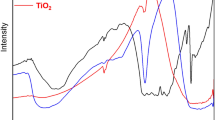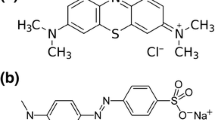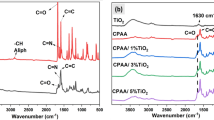Abstract
Photocatalysis is considered a useful technique employed for the dye degradation through solar light, visible or UV light irradiation. In this study, TiO2, g-C3N4, and TiO2-g-C3N4 nanocomposites were successfully synthesized and studied for their ability to degrade Rhodamine B (RhB) and Reactive Orange 16 (RO-16), when exposed to visible light. The analytical techniques including XRD, TEM, SEM, DRS, BET, XPS, and fluorescence spectroscopy were used to explore the characteristics of all the prepared semiconductors. The photocatalytic performance of synthesized materials has been tested against both the selected dyes, and various experimental parameters were studied. The experimental results demonstrate that, in comparison to other fabricated composites, the TiO2-g-C3N4 composite with the optimal weight ratio of g-C3N4 (15 wt%) to TiO2 has shown outstanding degrading efficiency against RhB (89.62%) and RO-16 (97.20%). The degradation experiments were carried out at optimal conditions such as a catalyst load of 0.07 g, a dye concentration of 50 ppm, and a temperature of 50 ℃ at neutral pH in 90 min. In comparison to pure TiO2 and g-C3N4, the TiO2-g-C3N4, a semiconductor, has shown higher degradation efficiency due to its large surface area and decreased electron–hole recombination. The scavenger study gave an idea about the primary active species (−OH radicals), responsible for dye degradation. The reusability of TiO2-g-C3N4 was also examined in order to assess the composite sustainability.













Similar content being viewed by others
Data availability
The datasets used and analyzed during the study are available from the corresponding author upon reasonable request.
References
Adeel M, Saeed M, Khan I et al (2021) Synthesis and characterization of Co-ZnO and evaluation of its photocatalytic activity for photodegradation of methyl orange. ACS Omega 6:1426–1435. https://doi.org/10.1021/acsomega.0c05092
Alsalme A, Galal AH, El-Sherbeny EF et al (2022) Fabrication of S-scheme TiO2/g-C3N4 nanocomposites for generation of hydrogen gas and removal of fluorescein dye. Diam Relat Mater 122:108819. https://doi.org/10.1016/j.diamond.2022.108819
Ayub A, Raza ZA (2021) Arsenic removal approaches: a focus on chitosan biosorption to conserve the water sources. Int J Biol Macromol 192:1196–1216. https://doi.org/10.1016/j.ijbiomac.2021.10.050
Ayub A, Raza ZA, Majeed MI et al (2020) Development of sustainable magnetic chitosan biosorbent beads for kinetic remediation of arsenic contaminated water. Int J Biol Macromol 163:603–617. https://doi.org/10.1016/j.ijbiomac.2020.06.287
Ayub A, Srithilat K, Fatima I et al (2022) Arsenic in drinking water: overview of removal strategies and role of chitosan biosorbent for its remediation. Environ Sci Pollut Res 29:64312–64344. https://doi.org/10.1007/s11356-022-21988-z
Camposeco R, Zanella R (2022) Catalytic behavior of gold nanoparticles supported on a TiO2-Al2O3 mixed oxide for CO oxidation at low temperature. Environ Sci Pollut Res 29:76992–77006. https://doi.org/10.1007/s11356-022-21076-2
de Assis MLM, Junior ED, de Almeida JMF et al (2021) Photocatalytic degradation of Novacron blue and Novacron yellow textile dyes by the TiO2/palygorskite nanocomposite. Environ Sci Pollut Res 28:64440–64460. https://doi.org/10.1007/s11356-021-15519-5
Gao B, Wang J, Dou M et al (2020) Enhanced photocatalytic removal of amoxicillin with Ag/TiO2/mesoporous g-C3N4 under visible light: property and mechanistic studies. Environ Sci Pollut Res 27:7025–7039. https://doi.org/10.1007/s11356-019-07112-8
Girish YR, Udayabhanu AG et al (2022) Facile and rapid synthesis of solar-driven TiO2/g-C3N4 heterostructure photocatalysts for enhanced photocatalytic activity. J Sci-Adv Mater Dev 7:100419. https://doi.org/10.1016/j.jsamd.2022.100419
Guo X, Duan J, Li C et al (2020) Fabrication of g-C3N4/TiO2 photocatalysts with a special bilayer structure for visible light photocatalytic application. Colloids Surf a: Physicochem Eng Asp 599:124931. https://doi.org/10.1016/j.colsurfa.2020.124931
Jeyaraja S, Palanivel S, Palanimuthu K, Munusamy C (2022) Phycocyanin from Spirulina platensis bio-mimics quantum dots photocatalytic activity: a novel approach for dye degradation. Environ Sci Pollut Res 29:68280–68292. https://doi.org/10.1007/s11356-022-20563-w
Kholikov B, Hussain J, Zeng H (2021) Gold modified TiO2/g-C3N4 for enhanced photocatalytic activities to evolved H2 fuel. Inorg Chem Commun 131:108787. https://doi.org/10.1016/J.INOCHE.2021.108787
Kotkar SN, Prasad S, Gadekar GP, Rewatkar SB (2022) Auto combustion synthesis of ZnO for degradation of organic dye under natural solar light with bactericidal activity. Inorg Chem Commun 144:109830. https://doi.org/10.1016/j.inoche.2022.109830
Kumar OP, Ahmad M, Nazir MA et al (2022) Strategic combination of metal–organic frameworks and C3N4 for expeditious photocatalytic degradation of dye pollutants. Environ Sci Pollut Res 29:35300–35313. https://doi.org/10.1007/s11356-021-17366-w
Liu W, Wang Y, Qi K et al (2022) Broad spectral response Z-scheme three-dimensional ordered macroporous carbon quantum dots/TiO2/g-C3N4 composite for boosting photocatalysis. Langmuir 38:4839–4847. https://doi.org/10.1021/acs.langmuir.1c03483
Ma L, Wang G, Jiang C et al (2018) Synthesis of core-shell TiO2@g-C3N4 hollow microspheres for efficient photocatalytic degradation of rhodamine B under visible light. Appl Surf Sci 430:263–272. https://doi.org/10.1016/j.apsusc.2017.07.282
Mehregan S, Hayati F, Mehregan M et al (2022) Exploring the visible light–assisted conversion of CO2 into methane and methanol, using direct Z-scheme TiO2@g-C3N4 nanosheets: synthesis and photocatalytic performance. Environ Sci Pollut Res 29:74951–74966. https://doi.org/10.1007/S11356-022-21048-6/FIGURES/9
Moustafa HM, Mahmoud MS, Nassar MM (2022) Kinetic analysis of p-rGO/n-TiO2 nanocomposite generated by hydrothermal technique for simultaneous photocatalytic water splitting and degradation of methylene blue dye. Environ Sci Pollut Res. https://doi.org/10.1007/s11356-022-23430-w
Pattanayak DS, Pal D, Mishra J et al (2022) Doped graphitic carbon nitride (g-C3N4) catalysts for efficient photodegradation of tetracycline antibiotics in aquatic environments. Environ Sci Pollut Res. https://doi.org/10.1007/s11356-022-19766-y
Raziq F, Li C, Humayun M et al (2015) Synthesis of TiO2/g-C3N4 nanocomposites as efficient photocatalysts dependent on the enhanced photogenerated charge separation. Mater Res Bull 70:494–499. https://doi.org/10.1016/J.MATERRESBULL.2015.05.018
Saeed M, Muneer M, Haqul A, Akram N (2022) Photocatalysis: an effective tool for photodegradation of dyes-a review. Environ Sci Pollut Res 29:293–311. https://doi.org/10.1007/s11356-021-16389-7
Sanakousar MF, Vidyasagar CC, Jiménez-Pérez VM et al (2021) Efficient photocatalytic degradation of crystal violet dye and electrochemical performance of modified MWCNTs/Cd-ZnO nanoparticles with quantum chemical calculations. J. Hazard. Mater Adv 2:100004. https://doi.org/10.1016/j.hazadv.2021.100004
Sanakousar FM, Vidyasagar C, Jiménez-Pérez VM, Prakash K (2022a) Recent progress on visible-light-driven metal and non-metal doped ZnO nanostructures for photocatalytic degradation of organic pollutants. Mater Sci Semicond Process 140:106390. https://doi.org/10.1016/j.mssp.2021.106390
Sanakousar MF, Vidyasagar CC, Jiménez-Pérez VM et al (2022b) Mechanistic insight into the photocatalytic degradation of organic pollutants and electrochemical behavior of modified MWCNTs/Cu–Co3O4 nanocomposites. React Chem Eng 7:1847–1872. https://doi.org/10.1039/D2RE00117A
Sun EC, Di WH, Zhang S et al (2022) Adsorption coupling photocatalytic removal of gaseous n-hexane by phosphorus-doped g-C3N4/TiO2/Zn(OAc)2-ACF composites. Environ Sci Pollut Res. https://doi.org/10.1007/s11356-022-22382-5
Tara N, Iqbal M, Habib FE et al (2021) Investigating degradation metabolites and underlying pathway of azo dye “Reactive Black 5” in bioaugmented floating treatment wetlands. Environ Sci Pollut Res 28:65229–65242. https://doi.org/10.1007/s11356-021-15130-8
Waghchaure RH, Adole VA, Jagdale BS (2022) Photocatalytic degradation of methylene blue, rhodamine B, methyl orange and Eriochrome black T dyes by modified ZnO nanocatalysts: a concise review. Inorg Chem Commun 143:109764. https://doi.org/10.1016/J.INOCHE.2022.109764
Wang P, Guo X, Rao L et al (2018) A weak-light-responsive TiO2/g-C3N4 composite film: photocatalytic activity under low-intensity light irradiation. Environ Sci Pollut Res 25:20206–20216. https://doi.org/10.1007/S11356-018-2201-1/FIGURES/11
Wang G, Li Y, Dai J, Deng N (2022) Highly efficient photocatalytic oxidation of antibiotic ciprofloxacin using TiO2@g-C3N4@biochar composite. Environ Sci Pollut Res 29:48522–48538. https://doi.org/10.1007/S11356-022-19269-W/FIGURES/10
Yu H, Zhang M, Lv J et al (2022) Fabrication of a stable light-activated and p/n type AgVO3/V2O5-TiO2 heterojunction for pollutants removal and photoelectrochemical water splitting. J Alloys Compd 894:162500. https://doi.org/10.1016/J.JALLCOM.2021.162500
Zada A, Qu Y, Ali S et al (2018) Improved visible-light activities for degrading pollutants on TiO2/g-C3N4 nanocomposites by decorating SPR Au nanoparticles and 2,4-dichlorophenol decomposition path. J Hazard Mater 342:715–723. https://doi.org/10.1016/J.JHAZMAT.2017.09.005
Zhang M, Han N, Fei Y et al (2021) TiO2/g-C3N4 photocatalyst for the purification of potassium butyl xanthate in mineral processing wastewater. J Environ Manage 297:113311. https://doi.org/10.1016/J.JENVMAN.2021.113311
Funding
The authors gratefully acknowledge the financial support from the Researchers Supporting Project Number (RSP-2021/243) King Saud University, Riyadh, Saudi Arabia.
Author information
Authors and Affiliations
Contributions
Asma A. Alothman: experimental work. Asif Ayub: management of the entire project. Safa K. Hachim: physical studies and data interpretation. Borhan Mustafa Mohammed: transient current studies and proof reading. Farhat Hussain: optical studies and interpretation. Muhammad Altaf: literature search and data analysis. Zainab Jawad Kadhim: SEM and XRD analysis. Holya A. Lafta: write up the reaming manuscript. Yasir S. Alnassar: critical analysis and validation. Marwah A. Shams: critical analysis. Nada A. Almuhous: critical analysis. Mohamed Ouladsmane: critical analysis. Mika Sillanpaa: formal analysis.
Corresponding author
Ethics declarations
Ethical approval
Not applicable.
Consent to participate
Not applicable.
Consent for publication
Not applicable.
Competing interests
The authors declare no competing interests.
Additional information
Responsible Editor: Sami Rtimi
Publisher's note
Springer Nature remains neutral with regard to jurisdictional claims in published maps and institutional affiliations.
Rights and permissions
Springer Nature or its licensor (e.g. a society or other partner) holds exclusive rights to this article under a publishing agreement with the author(s) or other rightsholder(s); author self-archiving of the accepted manuscript version of this article is solely governed by the terms of such publishing agreement and applicable law.
About this article
Cite this article
Alothman, A.A., Ayub, A., Hachim, S.K. et al. Facile synthesis and comparative study of the enhanced photocatalytic degradation of two selected dyes by TiO2-g-C3N4 composite. Environ Sci Pollut Res 30, 37332–37343 (2023). https://doi.org/10.1007/s11356-022-24839-z
Received:
Accepted:
Published:
Issue Date:
DOI: https://doi.org/10.1007/s11356-022-24839-z




